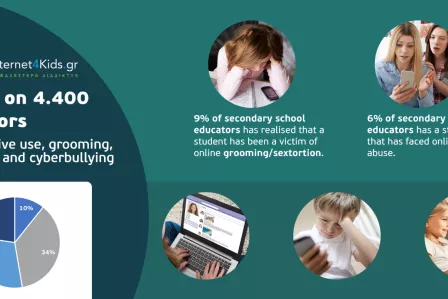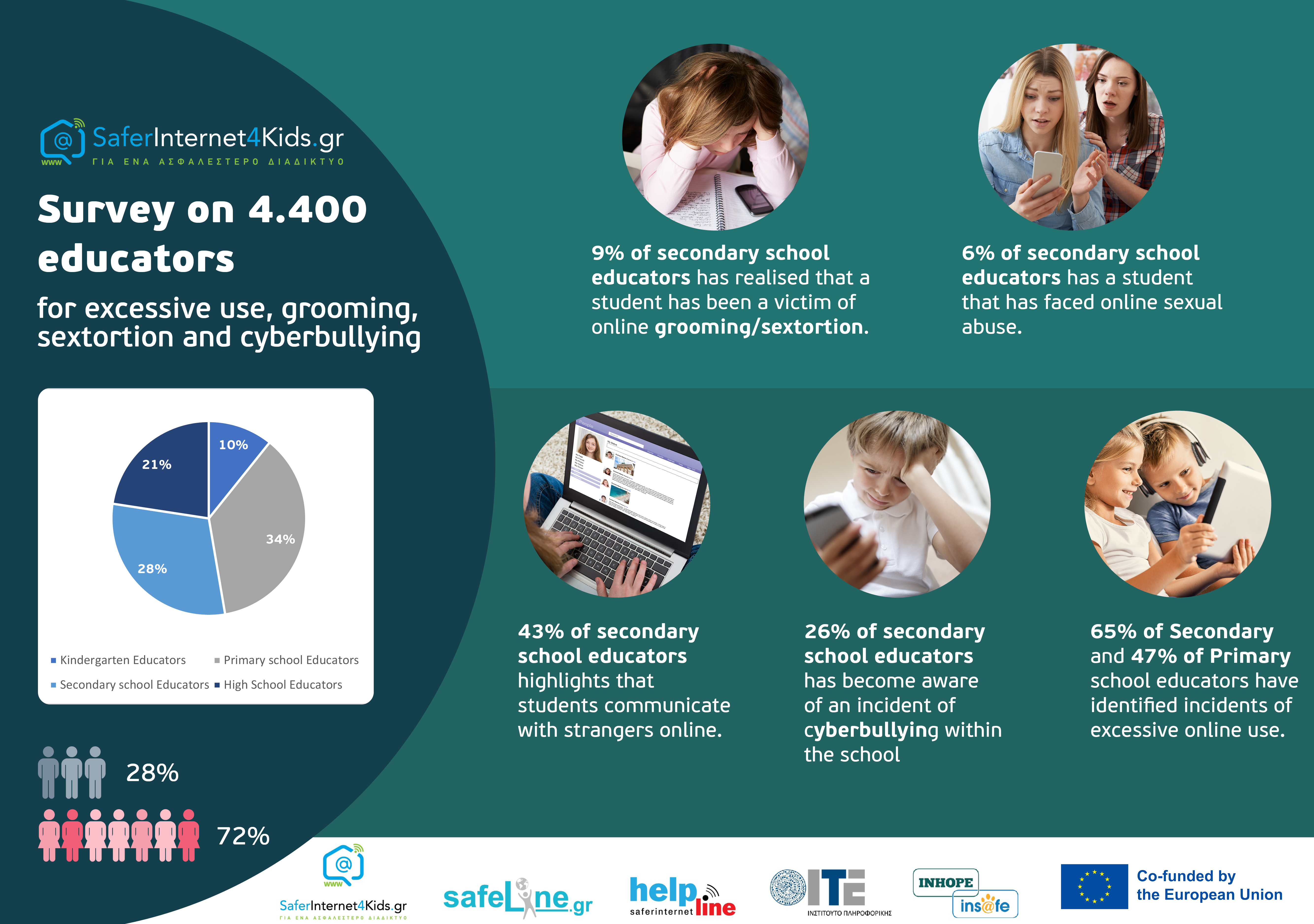The Greek Safer Internet Centre conducted a survey on 4,400 educators from all educational levels, in cooperation with the Panhellenic School Network. The survey was held from December 2022 till January 2023 via anonymous questionnaires.

The main findings
According to the survey, 9 per cent of secondary education teachers have recognised/learned that a student has been a victim of online harassment/grooming, and 6 per cent of them that a student has been a victim of online abuse. The corresponding percentage in primary education is 2 per cent for incidents of online harassment/grooming and 0.5 per cent for cases of online abuse. More than half of the surveyed educators from both educational levels (57 per cent in the general population, 54 per cent in primary, and 60 per cent in secondary) state that they are not aware of how to manage situations of online grooming/sextortion against their students.
A remarkable finding is that 65 per cent of secondary school educators and 47 per cent of primary school educators have recognised that a student is facing a problem of excessive online use. In fact, almost 59 per cent of secondary school educators state that, at the same time, they are not aware of how to manage it.
Furthermore, 44 per cent of secondary school educators and 23 per cent of primary school educators state that they have noticed a student chatting with strangers online either to a great extent or to a lesser extent.
26 per cent of secondary school educators and 9 per cent of primary school educators state that they have become aware of an incident of cyberbullying. From both educational levels, the majority (69 per cent) were informed about the incident by the students themselves and 13 per cent were informed by someone else. In fact, 42 per cent of educators of all levels (39 per cent in primary and 45 per cent in secondary) state that they do not know how to manage cyberbullying situations, with the majority of them teaching in high school (49 per cent).
Finally, 79 per cent of the respondents of the survey integrate the internet in their educational process, either on a daily basis or a few times per week, and only 2 per cent do not use it at all for the needs of their course.

About the survey
Read more about the survey and its results on the Greek Safer Internet Centre’s website.
Find more information about the work of the Greek Safer Internet Centre, including its awareness raising, helpline, hotline, and youth participation services – or find similar information for other Safer Internet Centres throughout Europe.
The Greek Safer Internet Centre conducted a survey on 4,400 educators from all educational levels, in cooperation with the Panhellenic School Network. The survey was held from December 2022 till January 2023 via anonymous questionnaires.

The main findings
According to the survey, 9 per cent of secondary education teachers have recognised/learned that a student has been a victim of online harassment/grooming, and 6 per cent of them that a student has been a victim of online abuse. The corresponding percentage in primary education is 2 per cent for incidents of online harassment/grooming and 0.5 per cent for cases of online abuse. More than half of the surveyed educators from both educational levels (57 per cent in the general population, 54 per cent in primary, and 60 per cent in secondary) state that they are not aware of how to manage situations of online grooming/sextortion against their students.
A remarkable finding is that 65 per cent of secondary school educators and 47 per cent of primary school educators have recognised that a student is facing a problem of excessive online use. In fact, almost 59 per cent of secondary school educators state that, at the same time, they are not aware of how to manage it.
Furthermore, 44 per cent of secondary school educators and 23 per cent of primary school educators state that they have noticed a student chatting with strangers online either to a great extent or to a lesser extent.
26 per cent of secondary school educators and 9 per cent of primary school educators state that they have become aware of an incident of cyberbullying. From both educational levels, the majority (69 per cent) were informed about the incident by the students themselves and 13 per cent were informed by someone else. In fact, 42 per cent of educators of all levels (39 per cent in primary and 45 per cent in secondary) state that they do not know how to manage cyberbullying situations, with the majority of them teaching in high school (49 per cent).
Finally, 79 per cent of the respondents of the survey integrate the internet in their educational process, either on a daily basis or a few times per week, and only 2 per cent do not use it at all for the needs of their course.

About the survey
Read more about the survey and its results on the Greek Safer Internet Centre’s website.
Find more information about the work of the Greek Safer Internet Centre, including its awareness raising, helpline, hotline, and youth participation services – or find similar information for other Safer Internet Centres throughout Europe.
- grooming excessive use of technology education cyberviolence cyberbullying
Related content
- < Previous article
- Next article >












